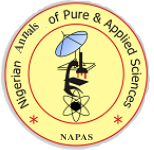Mosquito Species Abundance, Distribution and Diversity in Ughelli North Local Government Area, Delta State, Nigeria
DOI:
Keywords:
Culex quinquefasciatus, Aedes aegypti, C. nebulosus, Anopheles, Aedes, CulexAbstract
This research was carried out to record mosquito species abundance, distribution, diversity and breeding sites in four villages of Ughelli North Local Government Area of Delta State. Potential habitats of mosquitoes were sampled using dippers, hand-lens and plastic containers between June and November 2014. A total number of 274 sites were examined and only 146 were positive for mosquito larvae. The habitats sampled include domestic containers 107(39.05%), puddles 59(21.53%), tyres 47(17.15%) and drains 61(22.26%). The variation in the number of larvae collected from the various habitats were not significant (P=0.1203, F=2.705 and df= 3). One thousand six hundred and fifty-three (1.653) mosquito larvae were collected and reared to adults. Seven hundred and twelve (712) of the larvae emerged as adults that were separated into three genera: Anopheles, Aedes and culex and identified up to species level. Culex quinquefasciatus was found to be the most abundant (29.35%) in the study area, followed by Aedes aegypti (25.70%). C. nebulosus was the least abundant species with 2.95 %. Domestic containers were the most preferred breeding habitats for all the mosquito species and the variation in the species of mosquito with respect to types of habitat showed significant association in Ofuoma (P=0.0167, F=4.322,df=3) and Adjekota (P=0.0252, F=3.852, df=3). There was significant difference in the occurrence of mosquito species in the month of September (p value 0.0085) compared to June (p value 0.0518), July (p value 0.2370), August (p value 0.1920), October (p value 0.0534) and November (p value 0.0241. Variations existed in the physico-chemical parameters in the different sources of collections in different locations. Temperature ranged from 20.0 to 24.60C while pH (hydrogen ion concentration) range was 6.9 – 7.7 and Dissolved oxygen (D.O) ranged between 1.4 and 2.7(mg/L) as Conductivity ranged between 67.9 and 82.1(μs) and turbidity varied from 62.0NTU in the container samples to 84.2NTU in the gutter samples and depth varied between 6.3 and 68.3(cm) across the different locations but depth ranged from 6.3cm to 68.3cm and temperature was (22.8±2.6), Analysis of variance (ANOVA) and mean was used to determine the significant differences (p<0.05) in habitats and species distribution while Shannon Wiener and Simpson indices were used to determine species diversity and abundance. There is need for concerted efforts in mosquito control in Ughelli North to mitigate the incidence of mosquito transmitted diseases.



 Contact Us
Contact Us Editorial Team
Editorial Team Join As A Reviewer
Join As A Reviewer  Request For Print Copy
Request For Print Copy


 Cprint Publishers
Cprint Publishers